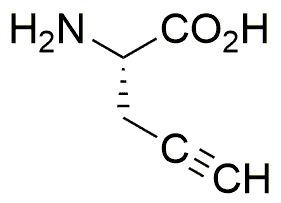L-Propargylglycine is widely utilized in research focused on:
- Biochemical Research: It serves as a potent inhibitor of the enzyme cystathionine gamma-lyase, which is crucial in studying sulfur metabolism and its implications in various diseases.
- Neuroscience: Researchers use it to investigate the role of hydrogen sulfide in neuroprotection and neurodegenerative diseases, providing insights into potential therapeutic strategies.
- Pharmaceutical Development: This compound is explored for its potential use in developing drugs targeting metabolic disorders, particularly those linked to cysteine and homocysteine metabolism.
- Agricultural Science: It is being studied for its effects on plant growth and stress responses, offering potential applications in enhancing crop resilience.
- Analytical Chemistry: L-Propargylglycine is utilized as a standard in various analytical methods, aiding in the accurate measurement of related compounds in biological samples.
General Information
Properties
Safety and Regulations
Applications
L-Propargylglycine is widely utilized in research focused on:
- Biochemical Research: It serves as a potent inhibitor of the enzyme cystathionine gamma-lyase, which is crucial in studying sulfur metabolism and its implications in various diseases.
- Neuroscience: Researchers use it to investigate the role of hydrogen sulfide in neuroprotection and neurodegenerative diseases, providing insights into potential therapeutic strategies.
- Pharmaceutical Development: This compound is explored for its potential use in developing drugs targeting metabolic disorders, particularly those linked to cysteine and homocysteine metabolism.
- Agricultural Science: It is being studied for its effects on plant growth and stress responses, offering potential applications in enhancing crop resilience.
- Analytical Chemistry: L-Propargylglycine is utilized as a standard in various analytical methods, aiding in the accurate measurement of related compounds in biological samples.
Documents
Safety Data Sheets (SDS)
The SDS provides comprehensive safety information on handling, storage, and disposal of the product.
Product Specification (PS)
The PS provides a comprehensive breakdown of the product’s properties, including chemical composition, physical state, purity, and storage requirements. It also details acceptable quality ranges and the product's intended applications.
Certificates of Analysis (COA)
Search for Certificates of Analysis (COA) by entering the products Lot Number. Lot and Batch Numbers can be found on a product’s label following the words ‘Lot’ or ‘Batch’.
*Catalog Number
*Lot Number
Certificates Of Origin (COO)
This COO confirms the country where the product was manufactured, and also details the materials and components used in it and whether it is derived from natural, synthetic, or other specific sources. This certificate may be required for customs, trade, and regulatory compliance.
*Catalog Number
*Lot Number
Safety Data Sheets (SDS)
The SDS provides comprehensive safety information on handling, storage, and disposal of the product.
DownloadProduct Specification (PS)
The PS provides a comprehensive breakdown of the product’s properties, including chemical composition, physical state, purity, and storage requirements. It also details acceptable quality ranges and the product's intended applications.
DownloadCertificates of Analysis (COA)
Search for Certificates of Analysis (COA) by entering the products Lot Number. Lot and Batch Numbers can be found on a product’s label following the words ‘Lot’ or ‘Batch’.
*Catalog Number
*Lot Number
Certificates Of Origin (COO)
This COO confirms the country where the product was manufactured, and also details the materials and components used in it and whether it is derived from natural, synthetic, or other specific sources. This certificate may be required for customs, trade, and regulatory compliance.


